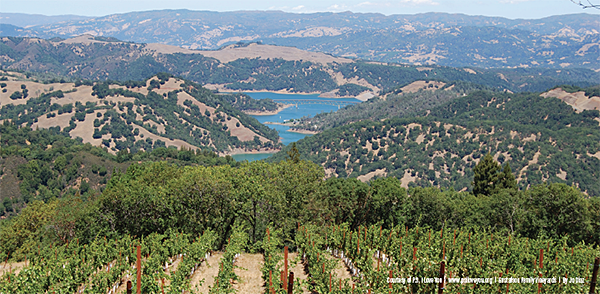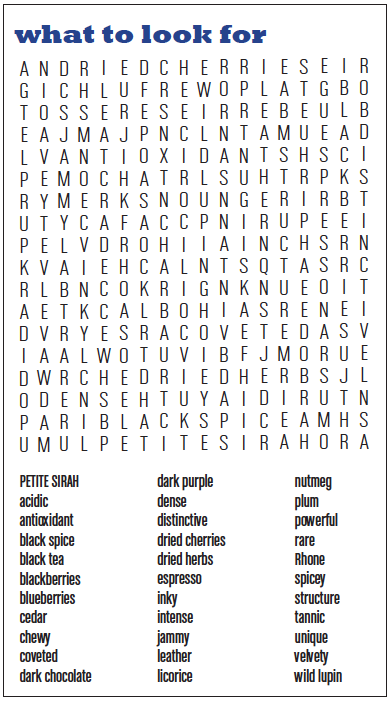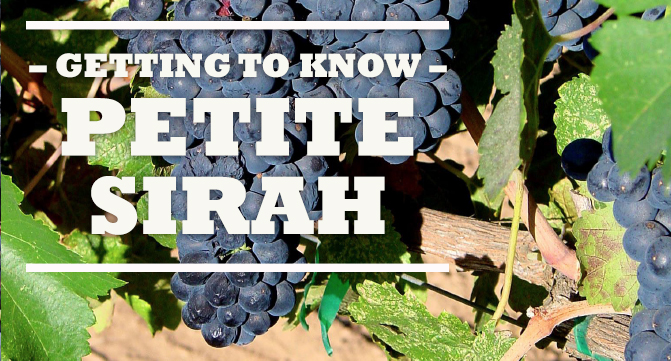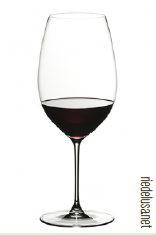Getting to Know Petite Sarah
“P.S. I Love You!” A glass of Petite Sirah a day just may keep the doctor away!
Petite Sirah contains very high levels of a powerful antioxidant called anthocyanin which is related to fighting free radicals, as well as potentially offering
anti-inflammatory, anti-viral and anti-cancer benefits.
Grown mainly in California, it is a rare grape variety with less than 10,000 acres planted worldwide including Australia and Israel. With few vineyards of Petite Sirah planted, it is a coveted favorite to those in-the-know and vintners usually produce limited supply each vintage.
Petite Sirah and Syrah have been the source of much confusion among wine drinkers over the years. Both grapes make big, rich, red wines, both are considered Rhône varieties and the similarity in the name. The wine is often mistaken for another kind of Syrah, or a “baby” Syrah. On the contrary, Petite Sirah is its own unique and distinctive variety with saturated color and dense fruit. The petite descriptor in the grape’s name is primarily used to denote the small size of the berries of the grape.
Petite Sirah is one of the biggest, most powerful and tannic wines produced in the United States. This grape produces inky dark, purple colored wines that offer flavors of dark plum, blackberries, blueberries, black spice, espresso and licorice. These wines are often massive, intense, chewy and masculine when young and offer big tannins with a good amount of acidity.
Originally known as Durif, Petite Sirah was created by Francois Durif, a botanist in Montpellier, France around 1880, who cross-bred Syrah and Peloursin, a nearly extinct grape. Then, in the mid-1800s Charles McIver imported the grape to America where it was renamed Petite Sirah. For decades, Petite Sirah became a favored grape variety of winemakers across California, particularly in Napa Valley where it was once the main grape planted.
Petite Sirah has somewhat of a cult following in California where there is a non-profit organization called P.S. I Love You whose mission is to promote Petite Sirah as a heritage variety with a special emphasis on its terroir uniqueness.

get the dirt
Understanding terroir and its influences
Like many other grape varieties, Petite Sirah is best when the fruit comes from old vines. Old vines are important because the grape is prone to high yields when young. Petite Sirah can be relatively easy to grow and seems to enjoy the diurnal temperature variations and sunshine of California.
Petite Sirah grows in a large variation of climates in California but in small amounts. The true spectrum of Petite Sirah styles is difficult to grasp because of this. It seems to prefer valley floor and warmer growing sites and is starting to really take hold areas such as Lodi and the Sierra Foothills.
It is often considered one of “America’s grapes” alongside Zinfandel and has a loyal following from those who enjoy the grape. Several California producers make wine from 100% Petite Sirah while others use it as a blending grape to add color and tannin structure.

swirl, sniff, sip, savor
How to identify wine in the glass
Petite Sirah has a lot of structure and is often used as a blending grape to add a bit of a backbone to a finished wine. It is packed with jammy fruit, bold body and a strong black tea-like tannin with medium acidity.
On it’s own, powerful fruit notes of dark plum, blueberry and blackberry come through the nose. On the palate, expect a burst of fruit that compliments the nose as well as a mouth-full of dark chocolate, a bit of black pepper finish and dense tannins.
The phenolic ripeness of Petite Sirah can help determine the final product in the bottle. Winemakers who use fruit from a cooler climate can expect a certain amount of pepper and spice similar in style to Syrah. In a warm climate, darker fruit characters tend to be more apparent.
how to pair like a pro
Full bodied red wines that have powerful tannins like Petite Sirah pair well with a wide variety of big dishes that are more rich in texture and substance. Petite Sirah’s bold fruit, solid tannins and crisp acidity pairs well with stews, braised and grilled meats like beef, lamb, veal and pork, as well as dishes with hearty, slightly acidic sauces. Short ribs, hamburgers and barbecue of all types work well with this hardy and dense tannic wine. Cheeses that fair nicely include include all kinds of cheddar and any pungent or bold-flavored cheeses like smoked Gouda and Parmigiano-Reggiano.
For the vegetarian, Petite Sirah is a great pairing for rich, creamy vegetable curries and matches nicely with dishes that have exotic spices and herbs such as black pepper, lavender, juniper and sage.
The best rule of thumb to use for pairing food with Petite Sirah is that the wine deserves a dish that is as big and bold as it is!
what’s in a glass?
Would wine in any other glass smell as sweet?
Petite Sirah has a high tannin structure and is a perfect red wine to decant and allow to blossom for a couple of hours. A great glass for a full-bodied red wine with ample tannin and big fruit such as Petite Sirah is one that has a narrow rim that helps deliver the wine to the center of the tongue.


